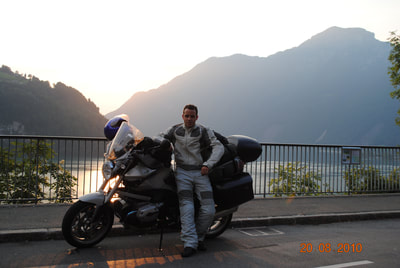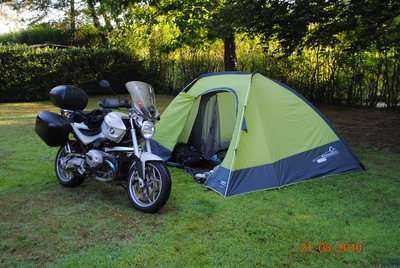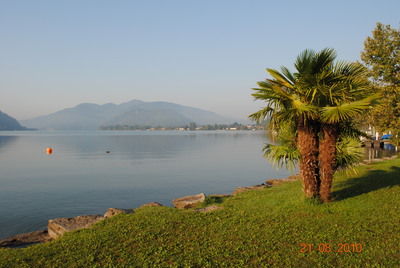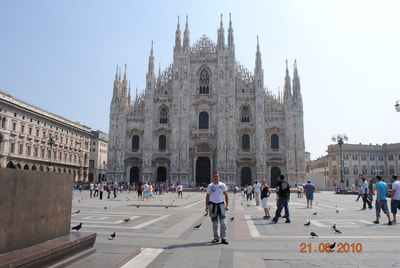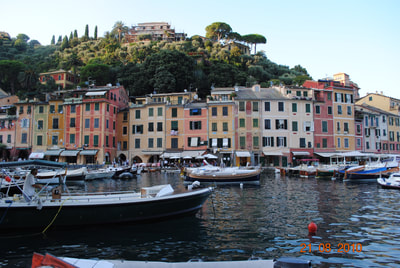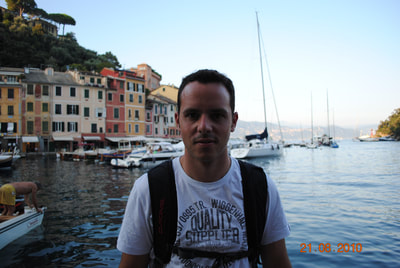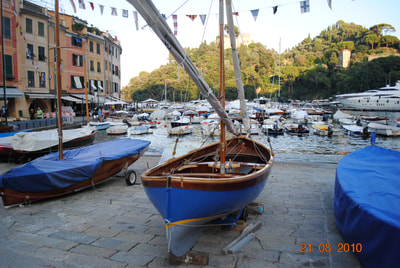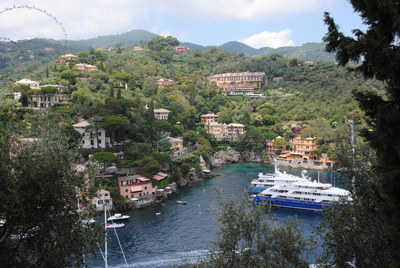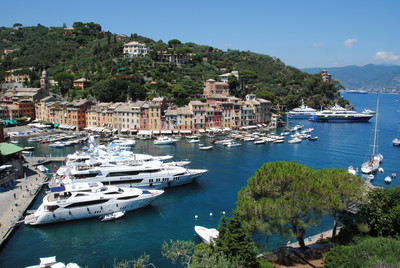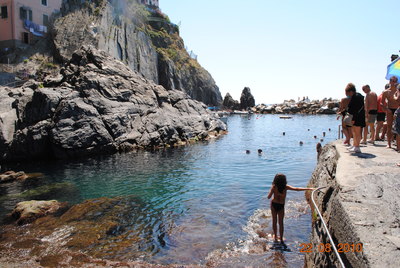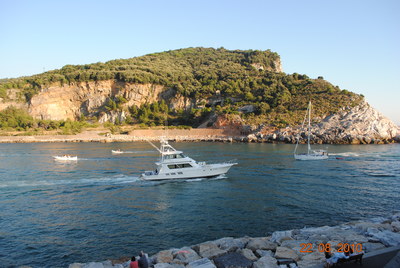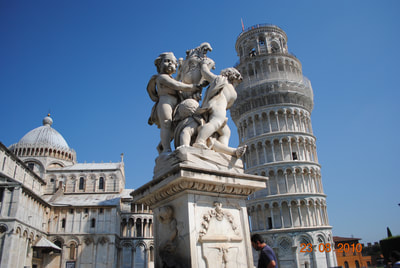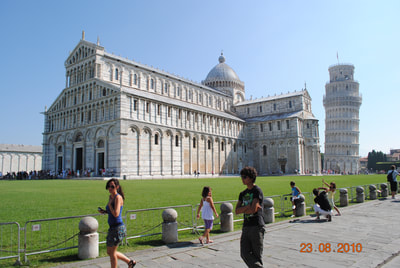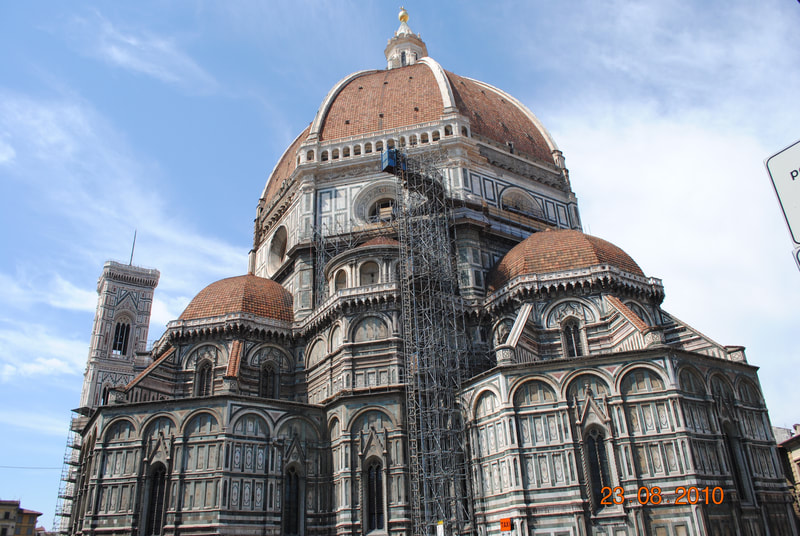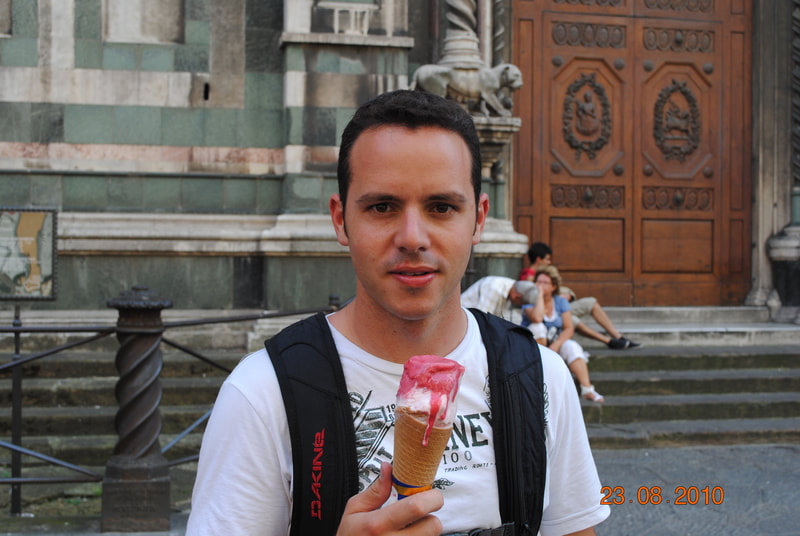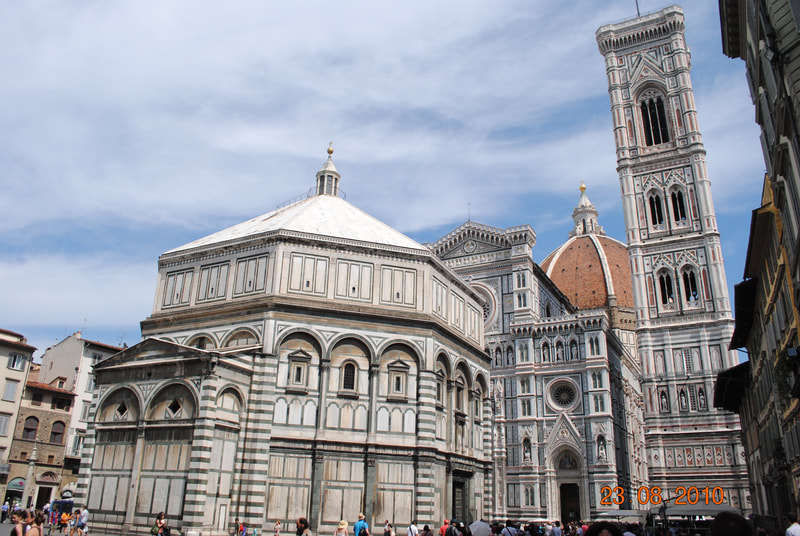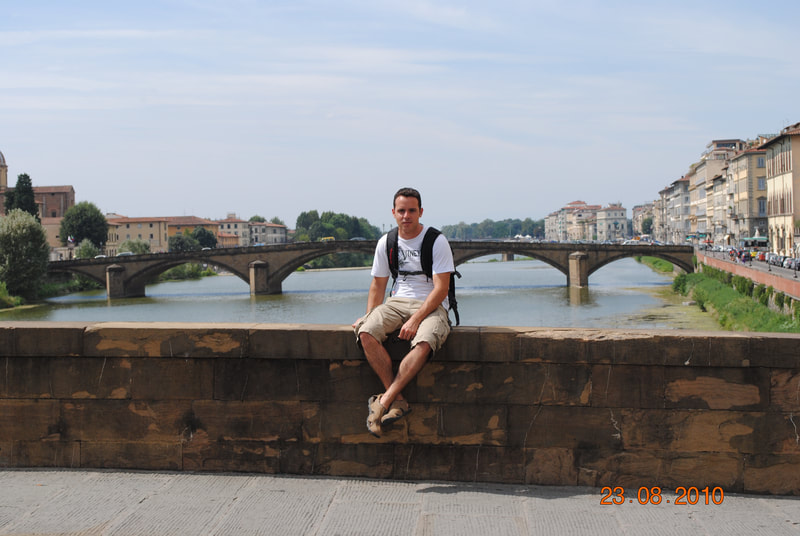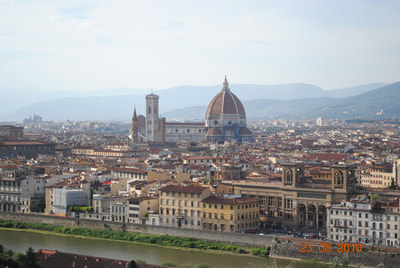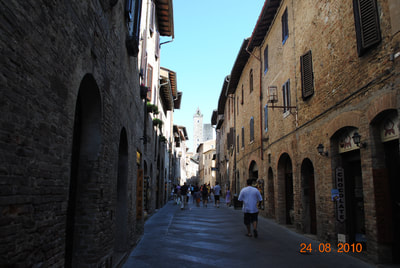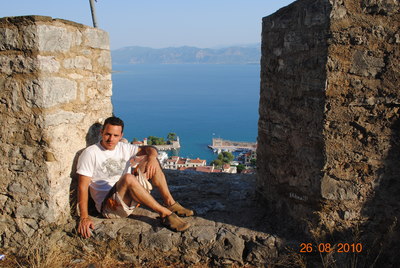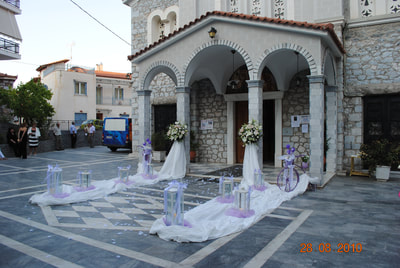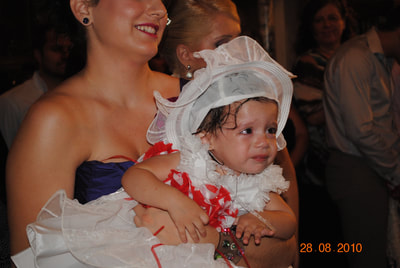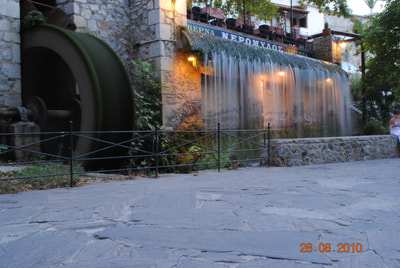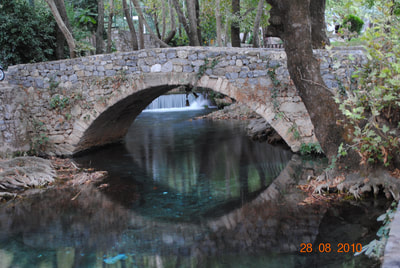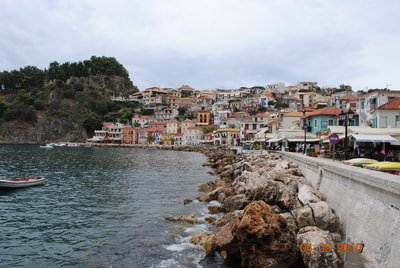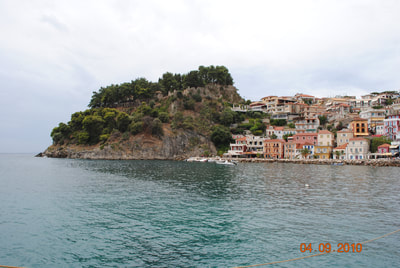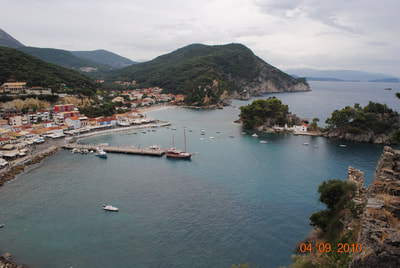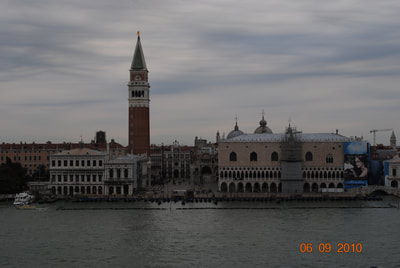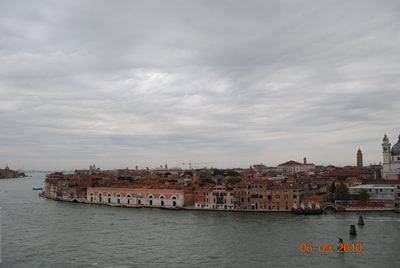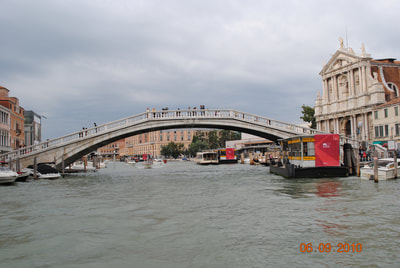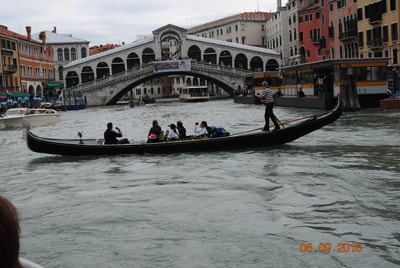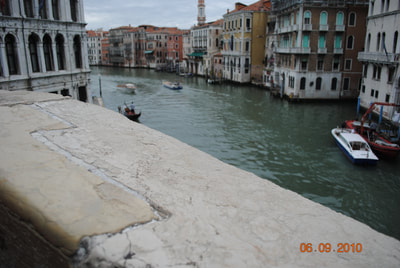Aug-Sep 2010 Distance: 4'000km Ferry trips: 2 Vehicle: BMW R1200R
As mentioned under "The Team" tab, this was my first trip to Greece and back on a bike. A destination that I repeated almost every summer in the ensuing years. It started on a Friday after work at the last week of August 2010. The weather forecast showed torrential rain every day before the start of the trip which really put me off. Luckily on the inaugural day of this trip the skies cleared and temperatures soared. Leaving work on a Friday evening the first stop had to be a camping place in Lugano which I reached just as the sun setted in the horizon. The next morning a took a memorable picture of my bike and my new tent, this trip being the first towards Greece, took another one of the palm trees by the lake next to the camping place, and set off direction Milan.
Arriving in Milan the first thing a biker should be aware of are the bumpy cobbled streets which very nicely decorate this city but is an utter nightmare for bikers. The icing on the cake is that many of these cobbled streets have tram lines situated a few inches deeper than the cobbles making it a slippery ramp and a hazard to the novice biker. If the roads are wet, go on foot, trust me. This being my first visit in Milan I was intrigued by the architecture of the Piazza del Duomo and the Sforza Castle. Of course no visit to Milan is not over without devouring a gelatto and an espresso. You can have a three-scoop icecream for 9 Euros here or EXACTLY the same ice cream here for 3 Euros. Choose wisely. A general rule about Italy: if you buy dinner / coffee / gelato the most expensive thing you pay is the view and not what you get. This beeing my first long bike trip I wasn't totally organised. I walked around the scorching heat in the centre of Milan in my bike trousers and leather boots cursing the umbearable heat. I did learn from this mistake and opted for a pac-safe mesh after my return, there I was able store all my bike clothes and walk around a city in summer without feeling as if I were in a sauna.
From Milan it was a straight line to Genoa. On the way, after consulting my map, I realised that there was a city between Milan and Genoa called Alessandria, what a great name for a city. Having Alexander the Great in mind and the 18 cities which he named after himself (don't believe me? click here) I thought that maybe this could be another great city with deep historical routes from the Greeks who lived in Magna Graecia. Now that I think about it, he must have been a bit of a narcissist to have given his name to so many cities. I had to see for myself. I arrived at Alessandria at noon and realised that the only life form existing in the streets were dead flies. There was really nothing to see here. After my return at the end of this trip I did ask a fellow Italian about Alessandria and was told that this is a central train hub only because of its industry but has no historical value whatsoever. Lesson learnt: do some research before vising a place. I got back on the saddle and headed to Genoa. The drive is a pretty boring straight line to Genoa as this part of Italy is a plateau, but bikers will get rewarded with a very curvy road with good asphalt 50km before Genoa, where I arrived at 14:00 in the afternoon. Feeling hungry I looked for a restaurant. To my horror this was the worst time one could find an open restaurant in northern Italy. It took me 2 hours of wondering around the city and visited around a dozen restaurants only to be turned away with the remark that la cucina (the kitchen) is aperta (open) from 12:00 to 13:30 and from 19:30 to 21:00 (in most cases). Are you having a laugh me fellow Italian? Yes, this was true. If you do find yourself in northern Italy be very carfeful with planning your lunch and dinner. I finally found an open sandwich place which served focaccia and quenched my hunger seconds before fainting from starvation.
In Genoa a mayor a couple of decades ago decided to solve the traffic problem by building a 2-lane highway that passed straight through the city, in order to alleviate the traffic caused by the huge number of trucks in this industrial part of Italy, which was aggrevating year by year. A tunnel proved too expensive, the second option was a bridge. The city constructed a 2-lane highway situated right in the centre and passes along the coast making it a freak structure in this otherwise beautiful city, or quoting Wagner, "Genoa is something incredibly beautiful" mentioned of course before the construction of this brutalist type of structure. The flyway now unfortunately lies immured in this coastal city forever, I though as I sat indignant under the bridge sipping an expresso listening to the the zooming noise of 20 ton trucks flrying over my head a few meters above. Well, every city has its foibles.
After Genoa came Santa Margherita Ligure where one can visit the Castelo. Dying of heat and watching the waves splash the jetty I decided that it was time to take the first dip in the sea. A small drive south brought me to Paraggi. The day was Sunday and the place was busking with bathers, finding a parking for the bike proved impossible. Italy being the birth place of the Vespa they were lined up along the beach without an inch of space between them. I managed to find a small gap, shifted a couple of vespas left and right to make space for my bike, and parked. I was dying to dip into the cool sea.
In Genoa a mayor a couple of decades ago decided to solve the traffic problem by building a 2-lane highway that passed straight through the city, in order to alleviate the traffic caused by the huge number of trucks in this industrial part of Italy, which was aggrevating year by year. A tunnel proved too expensive, the second option was a bridge. The city constructed a 2-lane highway situated right in the centre and passes along the coast making it a freak structure in this otherwise beautiful city, or quoting Wagner, "Genoa is something incredibly beautiful" mentioned of course before the construction of this brutalist type of structure. The flyway now unfortunately lies immured in this coastal city forever, I though as I sat indignant under the bridge sipping an expresso listening to the the zooming noise of 20 ton trucks flrying over my head a few meters above. Well, every city has its foibles.
After Genoa came Santa Margherita Ligure where one can visit the Castelo. Dying of heat and watching the waves splash the jetty I decided that it was time to take the first dip in the sea. A small drive south brought me to Paraggi. The day was Sunday and the place was busking with bathers, finding a parking for the bike proved impossible. Italy being the birth place of the Vespa they were lined up along the beach without an inch of space between them. I managed to find a small gap, shifted a couple of vespas left and right to make space for my bike, and parked. I was dying to dip into the cool sea.
A five minute drive south and one would find themselves in Portofino. The name literally meaning "fine port" is a very good place to park your million-dollar yacht, in case you had the luck of onwing such a thing. The houses along the coast of this tiny port are scrupulously ornamented to the last detail by skilled painters that embelished the external facades with their magic paintbrushes, every facade being an adorned piece of art. The ground floor of these edifices housing ice-cream parlours or eateries releasing the unmistacable pungent smell of fried calamari.
After leaving my megajacht in Portofino, I couldn't afford the tax anyway, let alone fuel, I finally headed towards Cinque Terre. Having heard so much about this place I was finally on my way there. Chinque Terre consists of breath-taking views, amazing landscape, steep cliffs, very windy roads and of course 5 distinct villages, hence its name. It is a place trying to attract only the wealthy tourists so the local district did manage to completely ban camping places, let alone free camping. Cinque Terre only offers hotels for accommodation. Me being on a scrooge budget, decided to camp at the last camping place there was, that being in Levanto just before the border West of Cinque Terre. The next day entered this province and out of the five villages I chose the nicest one of all, that being Manarola. After cooling down on the beach and walking along a foot-path promenade suspended on the side on vertical cliffs it was time so wave good bye to Cinque Terre.
Manarola village promenade SW of Manarola Manarola port
25km South of Manarola through a very windy hair-pinned road lies Porto Venere and its castle, the Doria Castle (see pictures below)
25km South of Manarola through a very windy hair-pinned road lies Porto Venere and its castle, the Doria Castle (see pictures below)
After a good night's sleep I was off to Pisa. This small town requires just a couple of hours of your free time to see the famous tower and it cathedral.
An hour's drive and I found myself in the undoubtedly magnificent city of Florence. I had visited Florence with my parents when I was little and was told by my dad that this city offers a great camping place with views of the whole city, called the Campegio di Michelangelo. This camping, as of 2015, is now unfortunatelly closed for good. Breathtaking views can still be seen at Piazzale Michelangelo very close to the old camping site. There I visited, among others, the Duomo, the Baptistry di San Giovanni , Palazzo Vecchio and finally Ponte Vecchio bridge. A walk up the Duomo is definietly worth the climb of 464 steps up to the top. The first flight of stairs will take you to the base of the dome where you can walk all around its edge. Looking down will definitely cause you slight nausea so it's not for the faint of heart. From there a few steps more through some narrow and low-ceiling corridors (mind your head) will reward you with a bird's eye view of the whole city. The tower to the West belongs to the Baptistry mentioned above.
Joke of the day: lots of people believe that Americans are between fat and obese. Not being prejudiced like the rest of you, the following took place while queing up at for the Duomo. A very big humanoid walked up to the queue of people and asked in his unequivocally loud american accent (I think you all know what that is) if there was a lift one could take to get to the top, to which I assured him that this is a 15th century cathedral and that no, Leonardo da Vinci did not install a lift, despite his unreservedly genius brain. He then insisted by asking again if there were perhaps an escalator going up, to which I assured him that da Vinci hadn't made plans for that either. He then alsked if perhaps there were an escalator or lift that could take him maybe half way up. People started laughing at his questions and wondering if this person was being serious. He left mumbling that "ok, then I won't go up" as he walked away, leaving the rest of us laughing at his comment and assuring us that yes, many americans (not all) are a bit heavier than the average homo-sapien. He can now go back to the USA, get a year's worth subscription of "LA Fitness" and come back next year with his new, and hopefully imporved, fitness state, and master the 464 steps that lay ahead. Best of luck my fellow human.
Joke of the day: lots of people believe that Americans are between fat and obese. Not being prejudiced like the rest of you, the following took place while queing up at for the Duomo. A very big humanoid walked up to the queue of people and asked in his unequivocally loud american accent (I think you all know what that is) if there was a lift one could take to get to the top, to which I assured him that this is a 15th century cathedral and that no, Leonardo da Vinci did not install a lift, despite his unreservedly genius brain. He then insisted by asking again if there were perhaps an escalator going up, to which I assured him that da Vinci hadn't made plans for that either. He then alsked if perhaps there were an escalator or lift that could take him maybe half way up. People started laughing at his questions and wondering if this person was being serious. He left mumbling that "ok, then I won't go up" as he walked away, leaving the rest of us laughing at his comment and assuring us that yes, many americans (not all) are a bit heavier than the average homo-sapien. He can now go back to the USA, get a year's worth subscription of "LA Fitness" and come back next year with his new, and hopefully imporved, fitness state, and master the 464 steps that lay ahead. Best of luck my fellow human.
Santa Maria del Fiore gelato on a hot day Battistero di San Giovanni
Ponte Vecchio (old bridge)
Arno river Campanille di Giotto Cathedral view from piazza Michelangelo
After Florence I headed towards San Gimignano, a Medieval city that looks exactly how it would have looked 1000 years ago, if you excluded the tourists with their selfie-sticks (why hasn't this been banned yet?). I walked through the city and visited its central square, its famous towers, the tallest one being Torre Grossa, and finally its famous Collegiate Church managing a few snaps while dodgig selfie-sticks and other 21st century health-hazards.
After Florence I headed towards San Gimignano, a Medieval city that looks exactly how it would have looked 1000 years ago, if you excluded the tourists with their selfie-sticks (why hasn't this been banned yet?). I walked through the city and visited its central square, its famous towers, the tallest one being Torre Grossa, and finally its famous Collegiate Church managing a few snaps while dodgig selfie-sticks and other 21st century health-hazards.
the streets of San Gimignano (GPS 43.4646, 11.0425)
After San Gimignano I headed towards Siena, famous for its horse races called Palio di Siena which take place twice a year. When the race is not on, as in my case, one can enjoy an espresso in the central square caled Piazza del Campo. Despite the name, no, you cannot camp there. You can dress like camp, but you can't actually camp.
After San Gimignano I headed towards Siena, famous for its horse races called Palio di Siena which take place twice a year. When the race is not on, as in my case, one can enjoy an espresso in the central square caled Piazza del Campo. Despite the name, no, you cannot camp there. You can dress like camp, but you can't actually camp.
From Siena driving west I went for a quick dip at lake Trasimeno. Disappointingly, although desperate for a bath, I got my trunks on, walked in, and my feet immediately started sinking in the find sand/mud that was adamant all along the coast. The feeling was ewwwywy... also dipping into the water up to my ankles, I could unfortunatelly not see my toes through the muddy water. Refreshing lake, yes, the cleanest and most enjoyable, saddly not. I opted for the showers which were placed on solid ground, after realising that coming out of this lake I would be dirtier than before going in. I then headed to Ancona. A good night's sleep at a 5-star camping place equipped with cinema and a swimming pool, the next morning I headed towards the port where I caught the ferry. It was good bye Italy, hello Greece. I arrived at Patras after a 22 hour ferry ride. There, driving down the ship ramp, the sizzling sun immediately caused drops of sweat to drip down my forehead. The first thing I realised was that no one was wearing a helmet, which puzzled me. I then suddenly hit me, like when you see your angry wife and don't know why and then remember it's her birthday that you forgot yet again, that I was in Greece i.e. helmets are for decorative purposes only, and for figting off the Persians but that's a whole different topic alltogether. The best thing now was to head straight to the beach. I headed North through the Rio-Antirrio bridge, a marvel of engineering which opened in the summer of 2004. It was the longest cable-stayed bridge in the world at the time.
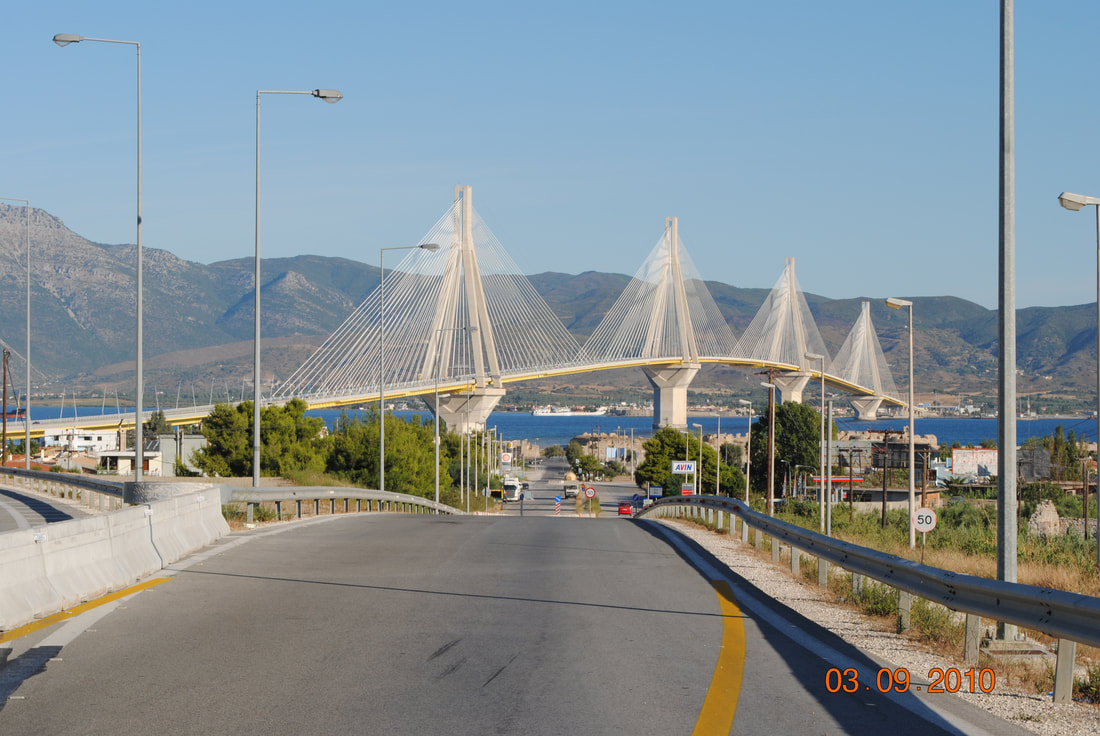 Rio-Antirrio bridge
Rio-Antirrio bridge
I crossed the Rio-Antirrio bridge and saw the toll sign: Cars: 11 Euros (one way), motorbikes: 1 Euro. Hey, getting cooked in the sun just saved me ten Euros, yeay! I mumbled. I headed to Nafpaktos, a very picteresque town, and then to Messolongi, where Lord Byron left his last breath after catching a deadly disease.
I then headed to Delphi, and then Livadia, a picteresque village, to attend a friend's wedding. I later realised that this was the first wedding I had attended as an adult, the ones your parents force you to go and hate every second don't count.
Above: wedding & christenting at Livadeia village.
After staying one night in Livadeia I headed to Athens. I left around noon and remember looking at the thermometer which showed 41 Degrees (yes, 41, this is not a typo). Opening the visor while on the move felt like a hair drier in the face. The air being very dry it was actually not as bad as I thought. I chose to take the highway to Athens keeping a constant speed and avoid traffic jams and, biker's nightmare, traffic lights. Sitting in a traffic light in this heat makes me more impatien than a taxi driver in Cairo. As soon as I reached Athens the heat became unbearable. Every traffic light I stopped would result in dropplets falling down my eyebrows. I disembarked the bike and took off all by gear except for the helmet and the gloves i.e. the bear minimum a biker should wear. I then rode very carefully on the sizzling tarmac below which had, at places, melted and looked like black chewing gum. After drinking a beer at Cafe Escoba, my North Athens hang-out place with Nick Foundoukos, I headed towards Piareus to catch the ferry to Crete.
The ensuing days in Crete I could say hi to my parents and relax from the hectic journey I had just undertaken. I was happy to go to the beach via car, not thinking of the heat or wearing a helmet and gear. A few days later I took the same ferry back to Piraeus, which usually docks around 6am i.e. before the hectic traffic starts in Athens. After driving off the ferry I headed west towards Patras, crossed the Rio-Antirrio bridge once again, and headed North and onto Lefkada island which is connected to the mainland via a bridge. The weather turned bad the next few days and being used to the 30's degree on the mercury scale I found it hard to adapt to 18 Degrees with drizzle. Driving a bike in constant drizzle is also no fun. After spending a night in the tent on Lefkada island I drove straight North to Parga and then Igoumenitsa, where I cought the ferry to Venice. Something I probably won't do again as it was a ca. 30 hour immencly monotonous journey where I lied captivated by the four walls of this ship.
After staying one night in Livadeia I headed to Athens. I left around noon and remember looking at the thermometer which showed 41 Degrees (yes, 41, this is not a typo). Opening the visor while on the move felt like a hair drier in the face. The air being very dry it was actually not as bad as I thought. I chose to take the highway to Athens keeping a constant speed and avoid traffic jams and, biker's nightmare, traffic lights. Sitting in a traffic light in this heat makes me more impatien than a taxi driver in Cairo. As soon as I reached Athens the heat became unbearable. Every traffic light I stopped would result in dropplets falling down my eyebrows. I disembarked the bike and took off all by gear except for the helmet and the gloves i.e. the bear minimum a biker should wear. I then rode very carefully on the sizzling tarmac below which had, at places, melted and looked like black chewing gum. After drinking a beer at Cafe Escoba, my North Athens hang-out place with Nick Foundoukos, I headed towards Piareus to catch the ferry to Crete.
The ensuing days in Crete I could say hi to my parents and relax from the hectic journey I had just undertaken. I was happy to go to the beach via car, not thinking of the heat or wearing a helmet and gear. A few days later I took the same ferry back to Piraeus, which usually docks around 6am i.e. before the hectic traffic starts in Athens. After driving off the ferry I headed west towards Patras, crossed the Rio-Antirrio bridge once again, and headed North and onto Lefkada island which is connected to the mainland via a bridge. The weather turned bad the next few days and being used to the 30's degree on the mercury scale I found it hard to adapt to 18 Degrees with drizzle. Driving a bike in constant drizzle is also no fun. After spending a night in the tent on Lefkada island I drove straight North to Parga and then Igoumenitsa, where I cought the ferry to Venice. Something I probably won't do again as it was a ca. 30 hour immencly monotonous journey where I lied captivated by the four walls of this ship.
The ferry reached Venice on a Monday morning. Despite being the beginning of September the weather here was also turning cold and miserable and it seemed like summer was over. After disembarking I headed straight to Venice town, a place I had last visited with my parents at the age of 15.
a 260km ride West would bring me to Milan, another 280km North would take me back to Zurich. I completed this distance, Venica to Zurich, almost in one go, which caused me the biggest back pain I have ever felt. When riding a bike, take brakes every max. 2 hours of riding. I also realised that I had brought with me around 10 t-shirts but only used 4 of them so all trips that followed were with much less gear. On your first trip you will guaranteed(trust me) pack much more stuff than you actually need, so this 3-week trip definitely tought me a lot for future trips. I was happy to be back in one piece and without a single mishap.

